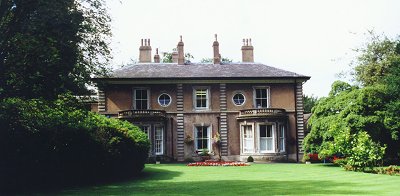|

Thanks to the Hospice and its Estate Manager for permission
to enter and photograph.
|
Listing: c.1845 with later alterations. By Edward Banks, with interior
design work by William Morris and Co., 1895-6.
Literature: Pevsner, p.326: "Compton Hall dates from c.1840-50,
rendered, modest in size, and still Latest Classical in its conventions. William
Morris designed the last of his wallpapers for this house and called it
'Compton'".
Historic Buildings of Wolverhampton (leaflet) No.5: Compton Hall, by David
Hill, Wolverhampton Heritage Project, nd. [The information in the Comment below
is largely based on this leaflet]
Wolverhampton Chronicle, September 12th 1906
Wolverhampton Chronicle, January 1907.
Comment: There is no hard evidence as to when the hall was built, or
who for, or who the architect was. But the best indications are that it was
built between 1840 and 1850, for Thomas Elwell, a hardware merchant, and that
the architect was Edward Banks, a leading Wolverhampton architect. In any event
Thomas Elwell owned the hall when he died in 1856, leaving it to his son
Charles. When Charles Elwell died in 1875 the property was sold to a Henry John
Denton, who sold it in 1884 to Sir John Morris, the Mayor of Wolverhampton who
had been unexpectedly knighted by Queen Victoria on her famous visit to
Wolverhampton in 1866. Sir John only held it for a year, selling it in 1885 to
William Hodson, a partner in the Springfield Brewery (Butlers). He died in 1890,
leaving the hall (and his interest in the brewery) to his son, Laurence W.
Hodson. This L. W. Hodson was a patron of the arts and a famous collector
of pre-Raphaelite paintings. He was an acquaintance of William Morris,
from whom he commissioned the Compton pattern wallpaper, the last wallpaper
designed by Morris. Presumably Hodson did this at the same time as he
engaged William Morris and Company to redesign the interior in 1895-6. These
decorations are still largely in place. In 1902 Hodson served as Chairman
of the Fine Art Committee for the Wolverhampton Art and Industrial Exhibition.
In 1906 Hodson got into financial difficulties. Since the brewery was
flourishing one can only suppose that Hodson had over extended his personal
expenditure, possibly on art. He sold the hall to Thomas Adams, a
Wolverhampton industrialist, who lived there until his death in 1939.
During the Second World War the Hall was used to house evacuees and was sold
after the war to a Mr. Jenks, who died almost at once. In July 1946 the Hall was
sold to the Wolverhampton and Midlands Eye Infirmary and used by them as a
nurses home; and the surrounding estate was sold for residential development. In
1969 the use as a nurses' home stopped and the Hall was empty for many years.
In 1976 plans were drawn up to convert the Hall, with a new extension for
wards, into a hospice. It was not officially opened until 9th November 1982,
when the Duchess of Kent (still the Patron) opened it. The Hall remains a
hospice, a highly valued and well supported institution in Wolverhampton.

|